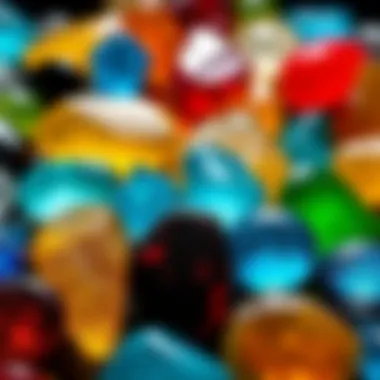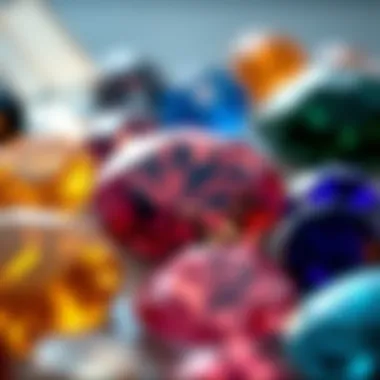In-Depth Analysis of Glass Stones and Their Impact


Intro
Glass stones have captured the imagination of artisans, collectors, and enthusiasts alike, carving a niche in both the realms of artistry and science. These multifaceted creations, far from mere fragments of glass, skillfully dance between the boundaries of nature and human ingenuity. What lies beneath their translucent coloring and reflective sheen? This exploration of glass stones intends to uncover the various elements that constitute their identity, from their formation to their captivating uses in modern life.
Understanding glass stones requires a closer look at their genesis. How do these eclectic pieces transform from raw materials into the polished gems we adore? A mix of science and craft plays a crucial role in this narrative, with a blend of minerals, colors, and methods bringing these stones to life. Delving deeper, we will traverse the realm of crafting techniques, from traditional methods to contemporary innovations. Also highlighted are various types of glass stones, elucidating their unique characteristics and desirability in the gemstone community.
Simultaneously, let’s not forget the metaphysical allure often associated with glass stones. Their spiritual connotations and healing properties resonate with many who seek solace or inspiration. By directly impacting jewelry design, glass stones have a substantial influence on modern trends that shape the marketplace.
Throughout this article, gemstone enthusiasts and industry professionals can anticipate a comprehensive analysis that harmonizes artistic appreciation with factual examination. Each section will tie together the aesthetic nuances and historical contexts that enrich our understanding of these crafted wonders.
Understanding Glass Stones
Understanding glass stones is crucial for gem enthusiasts, jewelry designers, and even casual collectors. Unlike traditional gemstones that occur naturally, glass stones represent a fascinating intersection of art and science. Their significance extends beyond mere aesthetics, contributing to various cultural narratives and providing a versatile medium for creative expression. In this article, we will unravel the complexities of glass stones—from their definitions and compositions to their practical uses and cultural meanings.
Definition and Composition
Glass stones are decorative materials made from processed glass, resulting in an array of colors and finishes. They originated from ancient civilizations that experimented with melting silicates to create stunning visual elements. Today, glass stones continue to be manufactured using similar principles, where raw ingredients like silicon dioxide are heated to around 2000 degrees Fahrenheit, transforming into a molten form. Once cooled and solidified, the result is a captivating stone-like object that mirrors the beauty of nature-made gems. The intrinsic qualities of glass, such as clarity, refractive index, and color, all contribute to the allure of glass stones, making them valuable in both decorative and practical applications.
Types of Glass Stones
Several classification methods exist for glass stones, with the distinction between natural and synthetic varieties being among the most significant. Understanding these types not only helps in appreciating their unique characteristics but also aids potential buyers in making informed choices.
Natural vs. Synthetic Glass Stones
When exploring the landscape of glass stones, it is critical to delineate between natural and synthetic types. Natural glass stones, though fewer in number, emerge from geological processes—taking millions of years of natural action like volcanic eruptions. Their key characteristic? Uniqueness. No two pieces are precisely alike, often adorned with the heartbeats of earth's history. However, the synthetic counterparts, produced in controlled environments, have their advantages as well.
Synthetic glass stones are often more accessible, allowing for mass production and a wider variety of styles. Their key feature is versatility. They can take shapes and colors that are often fancifully unattainable in nature, making them popular choices in modern jewelry design.
Yet, while synthetic stones can be gathered in bulk and are cost-effective, they may lack the mystique that natural stones possess. Each type has its own benefits and drawbacks, making it essential for buyers to know what they are seeking in aesthetics and value.
Common Varieties of Glass Stones
The world of glass stones encompasses a colorful array of varieties. Some of the most common types include:
- Murano Glass: Originating from the islands of Venice, known for its intricate designs and brilliant colors, often includes hand-blown masterpieces.
- Czech Glass: A favored choice in jewelry making, particularly for beads; these stones are made with precision crafting techniques, ensuring quality and consistency.
- Lead Glass: Also called crystal glass, known for its enhanced refractive qualities due to the inclusion of lead oxide—a popular choice in both glass ornaments and jewelry.
Each variety has its own appeal that continues to draw collectors and artisans alike. From dazzling Murano glass to the versatile Czech glass, these stones carry stories, evoke emotions, and embody the artistry of craft that appeals to enthusiasts of all stripes.
In summary, understanding the definitions, compositions, and types of glass stones paves the way for deeper exploration into their uses and significance in various fields, from art to healing practices.
The Formation of Glass Stones
Understanding how glass stones come to be is essential to grasp their unique characteristics and applications. This section delves into the manufacturing processes that create these striking materials, highlighting both the techniques and the properties that make glass stones desirable in various fields.
Manufacturing Processes
Melting and Molding Techniques
Melting and molding techniques are foundational in the creation of glass stones. These processes involve taking raw materials, primarily silica, and subjecting them to high temperatures until they transform into a molten state. One key characteristic of this method is its efficiency; it allows for the mass production of glass stones in various shapes and sizes.
A notable benefit of this approach is the ability to achieve consistent quality in the final product. The unique feature of melting and molding lies in the precision it offers—artisans can mold glass into elaborate designs with fine details. However, while this technique provides clarity and uniformity, it may limit creativity compared to other crafting methods that allow for more organic shapes.
Crafting Techniques Used in Glass Stone Production
Alongside melting and molding, various crafting techniques play a crucial role in glass stone production. Techniques such as lampworking, fusing, and slumping bring a more hands-on approach to glass-making. Crafting allows for a level of artistry that can’t be matched by mass production alone.
A highlight of these techniques is their capacity for individuality; each glass stone crafted can tell a unique story, offering customization that resonates deeply with jewelry designers and collectors alike. The uniqueness of handcrafted glass stones often results in limited quantities, adding to their allure. However, it's important to note that crafting can be time-consuming and more expensive, which can make it less accessible for some manufacturers.
Properties of Glass Stones


Physical Properties
The physical properties of glass stones are integral to their function and popularity. They are typically durable and resistant to scratching, which is a significant advantage for everyday wear in jewelry. Their well-known ability to reflect light beautifully adds to their appeal, making them a popular choice for decorative applications.
Another key characteristic is their weight; depending on the type, glass stones can feel substantial in a piece of jewelry, providing a quality presence. Yet, their fragility in comparison to harder gemstones can lead to concerns over breakage if not handled with care.
Optical Properties
Optical properties determine how a glass stone interacts with light, which is fundamental for achieving the desired aesthetic. The refractive index of glass allows it to emit a fascinating array of colors, especially when cut correctly. This property contributes significantly to the allure of glass stones, making them particularly sought after in jewelry-making.
The unique feature of optical properties is the potential for a variety of effects, such as fire, where the stone exhibits splendid colors like a rainbow when struck by light. On the downside, not all glass stones can achieve the same optical brilliance as genuine gems, which might lead some purists to favor traditional gemstones.
"The beauty of glass stones lies not just in their appearance, but in the stories of their creation and the craftsmanship involved."
In summary, the formation of glass stones is a complex interplay of creative techniques and inherent physical properties. Both the melting and molding processes and the artistry of crafting contribute to a rich array of options for jewelry designers and collectors alike. Understanding these processes not only enriches appreciation but also opens the door for new innovations within the realm of glass stones.
Applications of Glass Stones
The versatility of glass stones makes their applications quite vast. They are not just ornamental but serve multiple purposes across various fields. Understanding these applications is crucial as it reveals the importance of glass stones beyond mere aesthetics. From dazzling jewelry to artistic endeavors, their significance touches several aspects of contemporary life.
Glass Stones in Jewelry Design
Popular Jewelry Styles Incorporating Glass Stones
One of the most prominent areas where glass stones shine is in jewelry design. Understated yet eye-catching, glass stones are utilized in various styles ranging from vintage to modern pieces. Their vibrant colors can complement a multitude of fashion trends, making them a favorite among designers.
The unique spark and play of light in glass stones all through facets give them a characteristic brilliance reminiscent of traditional gemstones but at a fraction of the cost. This affordability makes them an accessible choice for both artisans and consumers, leading to their widespread use in numerous jewelry styles. For example, statement necklaces often feature clusters of larger glass stones, bringing a bold yet playful element to outfits.
Customization and Personalization
Customization plays a integral role when it comes to glass stones in jewelry. Because they're easier to manipulate than many natural gems, artisans can craft personalized pieces that reflect individual tastes and styles. Many buyers are drawn to the idea of having a unique piece that tells their story.
Moreover, adapting designs involves more than aesthetics; it includes matching color palettes and styles to personal outfits or gifting needs. Custom glass stone jewelry also allows for incorporation of symbols or birthstones, making it a meaningful choice that resonates with the wearer on a deeper level. However, one must consider that high levels of customization can lead to longer production times and varied cost implications.
Uses Beyond Jewelry
Crafting and Artistic Applications
Beyond the realm of jewelry, glass stones find a place in crafting and artistic endeavors. Many crafters enjoy using them in mixed media projects, where their various shapes and colors can add depth and texture. Items such as collages, mosaics, and decorative accents on household items often feature glass stones beautifully.
The distinct surface of each stone provides visual interest, and their lightweight nature allows for easy use in craft projects. However, it's essential to note that though glass stones are durable, they can still chip or break if not handled with care, which can be a drawback, especially in frequent use scenarios.
Interior Design and Decoration
Glass stones also shine in interior design and decoration. Their ability to catch light and create a shimmering effect makes them popular choices for decorative pieces in homes and offices. Items like glass vases filled with colorful stones or table lamps that incorporate glass stones can transform a simple space into one that feels vibrant and alive.
Using glass stones in decor is not only visually appealing but can also play into various design themes, from minimalist to bohemian. One must keep in mind that while they add extraordinary charm, overuse can lead to a cluttered look if not balanced accurately.
"The charm of glass stones lies in thier diverse applications, each bringing its own beauty to the table."
Metaphysical Properties of Glass Stones
The allure of glass stones goes beyond their aesthetic appeal; they are often attributed with various metaphysical properties that many enthusiasts find valuable. This section explores how these magnificent materials are believed to influence energy, wellness, and spirituality. By diving into the healing properties associated with glass stones, as well as their deeper spiritual significance, we can better appreciate their multifaceted role in both personal and cultural contexts.
Healing Properties
Chakra Associations
Chakras are often discussed in relation to holistic wellness, and glass stones are known to resonate with different energy centers of the body. Each type of glass stone might correlate with a specific chakra, helping to channel and balance energies. For instance, a rich blue glass stone could be linked to the throat chakra, potentially aiding communication and expression.


This connection is notable because it adds a layer of dimensionality to the healing properties glass stones are associated with. By embracing the chakra associations, individuals can work towards emotional and physical healing through targeted crystal usage.
One unique feature of chakra associations is their potential for personalization. Depending on what a person seeks—be it clarity, love, or success—selecting the right glass stone can serve as a focused tool. Yet, it’s worth mentioning that while these practices appeal to many, skepticism exists about their effectiveness, and some people may find the concept too abstract.
Balancing Energy with Glass Stones
Balancing energy is another significant aspect of the healing properties of glass stones. These stones are thought to absorb negative energy, helping regulate one’s personal space. For instance, people often use glass stones in meditation to enhance focus and calmness, creating a sense of tranquility.
This particular characteristic makes them a popular choice in stress relief and wellness practices. The clear nature of many glass stones allows them to serve as a physical representation of balance and peace.
However, it’s important to recognize that the effectiveness of glass stones in energy balancing can be subjective. What works wonders for one person might not yield the same results for another, leading to diverse views about their true impact.
Spiritual Significance
Symbolism in Different Cultures
The symbolic use of glass stones spans various cultures, enriching their significance. Some cultures have tied specific colors or shapes of glass stones to various elements of life, like love, prosperity, or protection. For example, a green glass stone may symbolize growth and renewal in cultures that emphasize nature's rebirth.
This cultural symbolism enhances the appeal of glass stones, as it connects individual use to broader historical contexts. It serves as a reminder that these materials have been revered for generations, offering a sense of heritage and continuity. This unique feature can lead to a deeper appreciation among collectors and enthusiasts, as they become custodians of cultural narratives.
Nonetheless, understanding these symbols requires some diligence. Not every culture uses the same meaning for the same stones, so individuals need to delve deeper if they are to fully appreciate these associations.
Spiritual Practices Involving Glass Stones
Spiritual practices involving glass stones often revolve around their perceived ability to promote mindfulness and self-awareness. Many practitioners incorporate glass stones into rituals, meditations, or even as talismans to attract specific energies. For instance, using a red glass stone during a ritual may be believed to invoke courage and strength.
One notable advantage of utilizing glass stones in spiritual practices is their accessibility. Unlike some rare gemstones, glass stones are readily available and affordable, allowing individuals to engage in spiritual practices without the financial burden of more precious materials.
However, relying solely on glass stones for spiritual empowerment can lead to unrealistic expectations. It's essential to understand that while they can enhance practices, the core experience usually stems from one's intentions and mindfulness, making plastic engagement potentially less effective.
Glass stones resonate far beyond mere aesthetics; their metaphysical properties connect individuals with deeper energies, cultural symbols, and spiritual practices.
In exploring the metaphysical properties of glass stones, we unearth layers of significance that intertwine wellness, culture, and spirituality. Each glass stone carries its own unique energy and story, inviting enthusiasts to explore and integrate these aspects into their daily lives.
Care and Maintenance of Glass Stones
Maintaining glass stones is not just about keeping them shining. It’s also essential for preserving their charm and integrity. Whether they are set in jewelry or displayed in collections, proper care ensures they continue to captivate. A small amount of effort can go a long way in prolonging the lifespan of these beautiful pieces.
Cleaning Techniques
Recommended Cleaning Materials
For cleaning glass stones, it’s crucial to select the right materials. Mild soap solutions work well, as they’re gentle yet effective. A soft cloth or microfiber towel is a recommended way to avoid scratches.
Another helpful option is ultrasonic cleaners. These devices can eliminate dirt and grime without any harsh scrubbing. The unique feature of the ultrasonic cleaner is that it sends sound waves, creating tiny bubbles that gently lift away impurities. However, it's vital to ensure that glass stones have no fragile settings before using this method. It’s worth noting, ultrasonic cleaning is becoming increasingly popular among gemstone enthusiasts and collectors, as it yields impressive results.
Pros and cons aside, always test any cleaning material on a small, hidden section of the stone, if possible, to ensure there's no adverse reaction.
Avoidable Practices
When it comes to caring for glass stones, certain cleaning practices should be avoided to prevent damage. For instance, using abrasive materials such as steel wool or coarse sponges can result in permanent scratches. Another aspect to dodge is submerging glass stones in harsh chemicals. Products containing bleach or ammonia might discolour or damage the surface.
The essential characteristic of avoiding such practices is that it helps in maintaining the original look of the stones. These decisions can seem trivial, however, neglecting them could lead to unforeseen consequences, detracting from the stone’s allure. Prioritize safety over convenience; choosing proper techniques makes all the difference in the longevity of your glass treasures.
Storage Tips
Optimal Storage Conditions
Maintaining glass stones requires thoughtful storage. Humidity and extreme temperatures can affect their integrity. Ideally, glass stones should be stored in cool, dry places. A dedicated jewelry box or pouch lined with soft fabric can offer protection against scratches and accidental damage.


A noteworthy consideration is the importance of separating each stone to prevent them from scratching each other. Using individual compartments or wrapping each stone in a soft cloth adds an extra barrier against wear.
The unique aspect of these storage conditions is that they ensure not only the preservation of physical appearance but also the value of the stones in a collector's context. Keeping stones in proper conditions can have significant implications for their market value over time.
Protecting from Wear and Tear
To shield glass stones from daily wear and tear, being mindful of how and where they are utilized is key. For example, removing rings or pendants before engaging in chores can avoid scratches and accidental impacts.
Additionally, avoiding exposure to direct sunlight or high humidity areas helps prevent fading or deterioration in quality. The main aspect of protecting glass stones is understanding their vulnerabilities and being proactive in safeguarding them.
In summary, caring for glass stones isn't overly complicated. It involves simple cleaning methods, avoiding harmful practices during cleaning, and ensuring proper storage conditions. Such attention to detail not only enhances their beauty but also preserves their significance over time.
Trends and Innovations in Glass Stones
The landscape of glass stones is shifting, reflecting the zeitgeist of contemporary design and consumer demand. It's crucial to understand these trends and innovations as they illuminate how preferences shape the future of this captivating material. They reveal not only aesthetic choices but also the underlying values in sustainability, craftsmanship, and technological advancements.
Emerging Styles in Jewelry
Contemporary Design Trends
Contemporary design trends in glass stones have moved towards minimalistic yet bold expressions. The emphasis here is on clean lines and vibrant colors that mimic natural stones while offering unique geometric shapes. One key characteristic of these trends is the balanced use of negative space, enhancing the visual impact of the stones themselves. This style is proving to be a crowd favorite among jewelers and consumers alike.
The idea is to create pieces that are not just accessories but statements. Such designs often lean towards being sustainable, using materials that are sourced responsibly.
Unique features include a focus on asymmetrical settings and untraditional cuts that challenge conventional jewelry aesthetics. The benefits of this trend are manifold—these designs cater to a diverse audience, from the avant-garde fashionistas to those who prefer timeless elegance. However, the challenge remains in balancing uniqueness with wearability, as overly intricate designs may not appeal to everyone.
Influence of Technology on Glass Stone Design
Technology has become a significant player in the design and manufacturing of glass stones. With advancements in digital fabrication techniques, designers are able to experiment with complex geometries that were previously unachievable. The key characteristic of this trend is the integration of software like CAD to visualize and simulate designs before the production phase.
This approach offers a beneficial route for rapid prototyping, enabling jewelers to test usability and aesthetics efficiently. One noticeable unique feature is the incorporation of 3D printing technology, which allows for intricate designs that maintain structural integrity.
The advantages here include lower material waste and the potential for highly customizable designs that cater to individual preferences. However, the permanence of the technology can also pose drawbacks, as it sometimes leads to mass production over bespoke artistry, raising questions about authenticity in craftsmanship.
Sustainability in Glass Stone Production
Sustainability has become a hot button issue in various industries, and the glass stone market is no exception. Consumers are increasingly looking for products that not only meet their aesthetic desires but also align with their values regarding the environment.
Eco-Friendly Manufacturing Practices
Eco-friendly manufacturing practices in glass stone production mean reducing waste and utilizing renewable resources wherever possible. A significant aspect of this trend is the reduction of energy consumption during the manufacturing process, which contributes positively to the overall carbon footprint.
The key characteristic that highlights the importance of eco-friendly practices is the emphasis on transparency in sourcing. Consumers today expect producers to disclose how raw materials are obtained, and this trend encourages responsible mining and recycling efforts.
One unique feature here is the exploration of alternative materials for glass stones that mimic traditional stones using post-consumer waste. The advantages of such practices are clear; the pledge towards sustainability improves brand loyalty and appeals to environmentally conscious consumers. That said, the initial investment in sustainable practices can deter businesses due to higher costs.
Recycling and Upcycling in the Industry
Recycling and upcycling in the glass stone industry offer an innovative way to repurpose existing materials into new designs. This trend harnesses the creativity of artisans, turning what would typically be waste back into objects of beauty. The key characteristic is the commitment to circular economy principles where waste is minimized, and resources are utilized to their fullest potential.
This practice not only speaks to environmental responsibility but also to a growing consumer base that values unique, one-of-a-kind items. A distinctive feature of this trend is the ability to tell a story through each piece, as many recycled materials carry their history.
The advantages here include creating a niche market for bespoke products while contributing to sustainability efforts. However, sourcing quality materials for upcycling can sometimes pose a challenge, as the supply may not always meet demand.
End
When we reflect on the world of glass stones, it’s clear that their significance extends far beyond mere aesthetics. This article has laid bare the multifaceted dimensions of glass stones, illustrating their journey from raw materials to dazzling features in jewelry and art. The importance of glass stones spans various aspects that cater not only to collectors but also to enthusiasts and designers alike.
Final Thoughts on Glass Stones
Glass stones embody both beauty and versatility, their appeal rooted in their unique characteristics and histories. Here are several key elements underscoring their relevance in today’s context:
- Cultural Significance: Different cultures attribute various meanings to glass stones, and their spiritual connections play a vital role in practices around the globe.
- Innovation in Design: As trends evolve, so do the uses and designs of glass stones. Contemporary jewelry extends innovative boundaries, marrying technology with ancient craftsmanship. This synthesis creates pieces that cater to modern tastes while retaining historical significance.
- Sustainability Practices: Understanding the sustainability aspect of glass stone production is critical in today’s eco-aware environment. Eco-friendly manufacturing techniques and the rising trend of recycling glass into artisanal crafts are reaping appreciation, making glass stones a more conscientious choice in their use.
- Educational Value: For gemstone enthusiasts and geology buffs, glass stones are a practical study subject. They represent an intersection of science and art, prompting deeper exploration into materials that often get overshadowed by precious stones.
- From chakra balancing to spiritual healing, each piece tells a story that resonates on personal and communal levels.
In closing, glass stones serve not only as artistic and ornamental objects but also as tools for education and cultural introspection. As such, they invite ongoing exploration and appreciation, proving that their world is indeed a captivating facet of our broader understanding of gems and materials. Whether adorning a necklace or standing alone as a collector's piece, glass stones hold a special place that deserves understanding and admiration.







